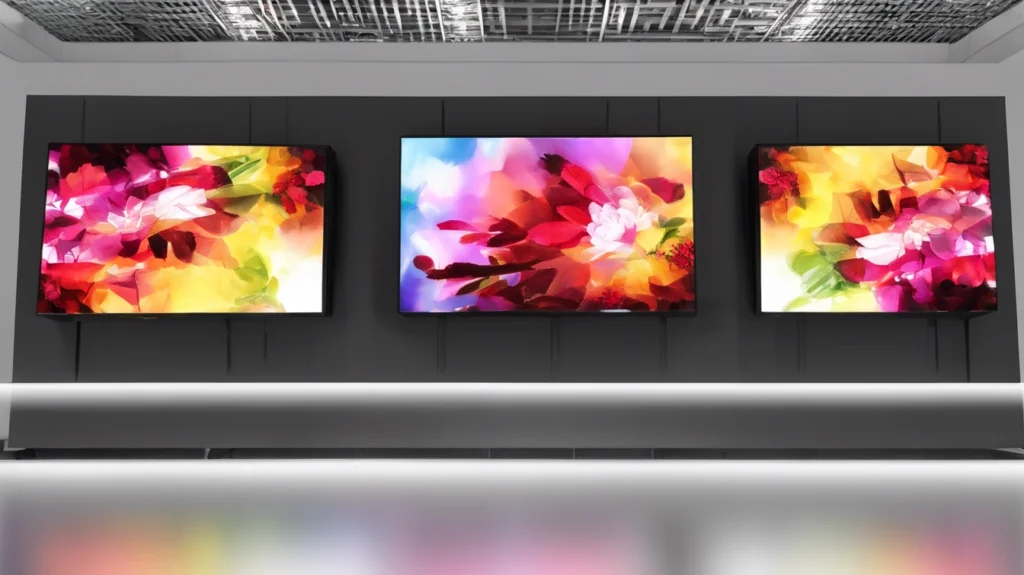LED Display Types
What Is LED?
LED, or Light Emitting Diode, is a semiconductor device that emits light when an electric current flows through it. The term “diode” refers to its ability to allow current to flow in only one direction, making LEDs highly efficient and long-lasting. This efficiency and longevity make LED technology a preferred choice for various display applications, from small indicator lights to large public displays.

Types of LED Displays
LED displays come in various types, each suited for different applications and environments. Here’s an overview of the main types:
- Text Display LEDs:
- Designed to show only text and alphanumeric information.
- Common in welcome boards at restaurants or “Open/Closed” signs in stores.
- The text is preprogrammed and fixed.
- Image Display LEDs:
- More sophisticated, capable of showing images along with text.
- Often used in simple billboards.
- The images and text are typically stationary.
- Video Display LEDs:
- Found in modern billboard ads, like those in Times Square.
- Feature high-pixel density LEDs to display moving images with high resolution.
- Digital Display LEDs:
- Designed to show numeric values, such as those on digital clocks or bank currency boards.
- Use seven-segment digital Nixie tubes to create digits.
- LED Lattice Image Text Displays:
- Can display both text and images simultaneously.
- Common in airports, concerts, and stadiums for dynamic text and still images.
- More versatile than text-only displays.

LED Display Technologies
Different technologies are used in LED displays to achieve various performance characteristics:
- Edge-Lit LED (ELED):
- LEDs are placed around the edges of the display.
- Light is directed into a light guide and then spread evenly across the screen by a diffuser.
- Common in budget-friendly LED displays.
- Direct-Lit LED:
- LEDs are placed directly behind the LCD screen in a grid pattern.
- Provides more uniform brightness and better contrast than ELED.
- Slightly more expensive than ELED displays.
- Full-Array LED:
- Similar to Direct-Lit but with more LEDs covering the entire back of the display.
- Features local dimming, allowing for better contrast and deeper blacks.
- Offers superior brightness and color accuracy.
- RGB LED:
- Each LED has red, green, and blue components.
- Can produce a wide range of colors by adjusting the brightness of each component.
- Popular in gaming and decorative lighting.
- Organic LED (OLED):
- The display itself emits light when current passes through organic compounds.
- No backlight required, making displays thinner.
- Offers infinite contrast ratio, faster response times, and better color accuracy.
- Quantum Dot LED (QLED):
- Enhances LCD-LED displays with quantum dot technology.
- Produces more vibrant colors and better contrast.
- More energy-efficient than traditional LCD-LED displays.
- Mini-LED:
- An advancement of QLED with smaller and more numerous LEDs.
- Allows for more precise control of black levels and contrast.
- Produces brighter and more detailed images.
- Micro-LED:
- Uses inorganic materials like Gallium Nitride instead of organic compounds.
- Produces brighter images with less power consumption.
- Offers higher durability and better performance than OLED.
Conclusion
LED technology has revolutionized the display industry, offering solutions for a wide range of applications from simple text displays to high-resolution video screens. The versatility, energy efficiency, and longevity of LEDs ensure they remain a cornerstone of modern display technology. Understanding the different types and technologies of LED displays helps in selecting the right display for specific needs, whether for personal use, advertising, or public information systems.





